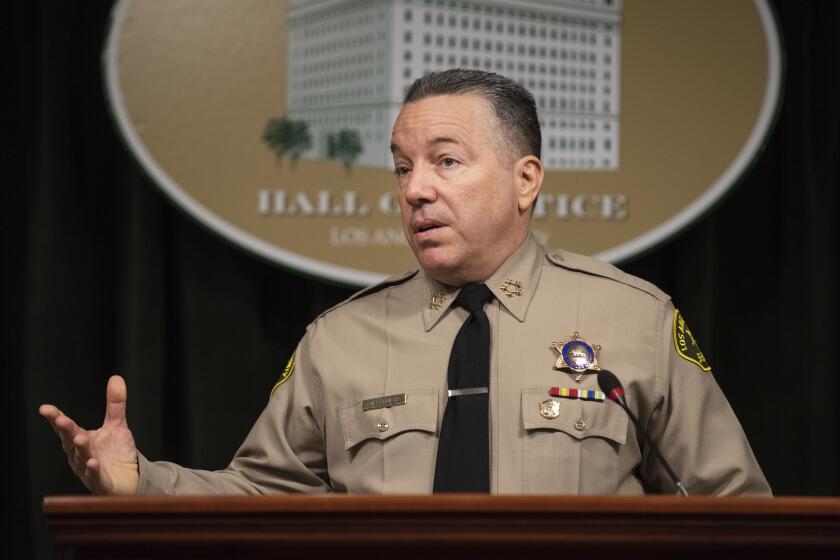Federal Drug Prosecutions Lag in L.A. : Crime: A study covering 1980 to 1987 shows 10 other big-city jurisdictions bringing charges at a higher rate than Los Angeles. A lack of assistant U.S. attorneys is blamed.
Los Angeles, now regarded as the nation’s “cocaine warehouse,” prosecuted federal narcotics violators at a lower rate from 1980 to 1987 than 10 other big-city jurisdictions, a new study disclosed Sunday.
The study also showed that the seven-county Central California District, which includes Los Angeles, failed to increase its per-capita prosecution rate of all federal criminal defendants, while a majority of the other jurisdictions that were studied posted increases.
The report is the first to compare activities of U.S. attorneys and seems to bolster the contention of those who maintain that Los Angeles is failing to receive its fair share of federal assistant prosecutors. The study, prepared by the Transactional Records Access Clearinghouse, a nonprofit research group at Syracuse University, is based on data from the Federal Judicial Center, a branch of the U.S. courts.
The report showed that 17% of the federal charges against individuals in Los Angeles were drug-related, versus 24% in all 11 prosecutors’ offices studied. In addition to Los Angeles, the study included Boston, Manhattan, Brooklyn, Baltimore, Philadelphia, Detroit, Chicago, San Francisco, Newark, N.J., and Hartford, Conn.
There were an average of 19 federal criminal defendants per 100,000 population in Los Angeles during the study period--a rate that ranked seventh among the 11 offices.
Gary Fees, acting U.S. attorney for Los Angeles, blamed the low prosecution rate on the fact that fewer federal prosecutors are assigned to the Los Angeles district than to some of the other cities studied.
He said that the lower drug prosecution rate reflects the “tugs and pulls” of other high-priority cases in the Central District of California. The area includes the counties of Los Angeles, Orange, Riverside, San Bernardino, San Luis Obispo, Santa Barbara and Ventura.
In addition to being faced with rising illicit drug violations, “we have an extraordinarily heavy caseload” of matters assigned high priority by the Justice Department in Washington, Fees said.
For example, he noted, the defense procurement fraud scandal had caused a heavy caseload in the Los Angeles area, where all of the top 100 defense contractors maintain at least one facility. Further, he noted, California has a heavy caseload from the savings and loan crisis, and both issues have been given a high priority by the Justice Department.
“All of these crimes are labor-intensive,” Fees added.
The lower rate of criminal defendants per 100,000 population “really shows how the (Justice) Department has understaffed this office,” Fees said. “This is what we’ve been complaining about (to Washington) for years.”
Fees said that in 1987, the last year in the TRAC analysis, Los Angeles had 100 assistant federal prosecutors, while Manhattan had 128. Yet the Los Angeles district had a population of nearly 12 million, compared to a little more than 4 million in Manhattan.
“You add 28 more assistants and shrink the population by 75%,” and the rate of crimes charged per 100,000 population will soar, Fees said.
Since 1987, Los Angeles has received about 30 more assistant U.S. attorneys, but Fees said he believes the office is still badly understaffed.
“You come down here and look at people with dark circles under their eyes because they’re fighting an avalanche (of federal crimes) and it gets pretty discouraging,” Fees said.
“Our guidelines (for deciding whether to prosecute) are much higher than we would like them to be precisely because of the number of assistants,” he noted.
While declining to disclose exact guidelines, he said, for example, that bank fraud cases involving less than $100,000 are being passed over in Los Angeles, while they are pursued in many other U.S. attorneys’ offices.
“Everybody agrees we’ve had a shortage of assistant U.S. attorneys,” said David Runkel, chief spokesman for Atty. Gen. Dick Thornburgh. The 1988 drug bill added 440 new assistants nationwide and the 1990 budget would add another 800 to 900, he said.
While the allocation of the new prosecutors among the 94 U.S. attorneys offices has not been decided, Runkel said, the drug and savings and loan situations make it likely that California districts will get a “substantial” number of the additional attorneys.
The 1987 cutoff of the TRAC data fails to take into account some sharp increases in drug prosecutions that took place the next year, Fees said.
The executive office of U.S. attorneys, the Justice Department unit that keeps track of the federal prosecutors’ activities in the field, disputed some of TRAC’s data. But David Burnham, associate research professor in the S.I. Newhouse School of Public Communication and co-author of the study, contended that the criticism involves “apples and oranges” comparisons--citing, for example, 1988 data, a year not covered in TRAC’s work.
More to Read
Sign up for Essential California
The most important California stories and recommendations in your inbox every morning.
You may occasionally receive promotional content from the Los Angeles Times.










